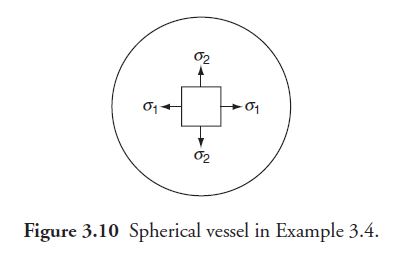Question 3.4: Find the increase in volume of a thin-walled spherical shell...
Find the increase in volume of a thin-walled spherical shell, subjected to uniform internal pressure p. Consider the internal radius to be r.
Learn more on how we answer questions.
For a spherical pressure vessel, we know from Eq. (3.4),
\sigma_1=\sigma_2=\frac{p r}{2 t} (3.4)
Let us consider an element as shown in Figure 3.10:
On this element, on two pairs of orthogonal surfaces stresses \sigma_1 \text { and } \sigma_2 act. From the generalised Hooke’s law [Eq. (1.14)], we can write for two-dimensional cases, that
\begin{aligned} & ∈_{x x}=\frac{\sigma_{x x}}{E}-\frac{\left(\sigma_{y y}+\sigma_{z z}\right)}{E} ν \\ & ∈_{y y}=\frac{\sigma_{y y}}{E}-\frac{\left(\sigma_{x x}+\sigma_{z z}\right)}{E} ν \\ &∈_{z z}=\frac{\sigma_{z z}}{E}-\frac{\left(\sigma_{x x}+\sigma_{y y}\right)}{E} ν \end{aligned} (1.14)
∈_x=\frac{\sigma_{x x}}{E}-ν \frac{\sigma_{y y}}{E} (1)
Using Eq. (1), we can compute the circumferential strain, ∈_{ C } as
\begin{aligned} ∈_C & =\frac{\sigma_1}{E}-ν \frac{\sigma_2}{E} \\ & =\frac{\sigma_1}{E}(1-ν) \quad\left(\text { as for spherical vessels, } \sigma_1=\sigma_2\right) \\ & =\frac{1}{E} \times \frac{p r}{2 t}(1-ν) \end{aligned}
As this is linear strain in circumferential direction, change in length of circumference is
(2 \pi r) \times \frac{p r}{2 E t}(1-ν)
Therefore, the new radius of the sphere is
\begin{aligned} r^{\prime} & =\frac{2 \pi r+2 \pi r(p r / 2 t E)(1-ν)}{2 \pi} \\ & =r+\frac{p r^2}{2 t E}(1-ν) \end{aligned}
Therefore, the new volume of the sphere is
\begin{aligned} V^{\prime} & =\frac{4}{3} \pi r^{\prime 3} \\ & =\frac{4}{3} \pi\left[r+\frac{p r^2}{2 t E}(1-ν)\right]^3 \end{aligned}
Hence, the volumetric change is given by
V^{\prime}-V=\frac{4}{3} \pi\left[r+\frac{p r^2}{2 t E}(1-ν)\right]^3-\frac{4}{3} \pi r^3
Expanding and consequently dropping higher order terms involving power of p/E, we get
\text { Volume change }=\frac{2 \pi p r^4}{E t}(1-ν)
Note that why do we drop powers of p/E? It is because generally p/E is around 0.001, which is quite small. Higher order terms are even smaller, so they are neglected.
Alternative Solution: The volumetric change in the above example can also be calculated as follows.
For spherical vessel, V = (4/3)πr³. Therefore, taking differentials, we get
\Delta V=4 \pi r^2 \Delta r
where Δr denotes small change in radius of the sphere. The volumetric strain, ∈_{ V } is
∈_{ V }=\frac{\Delta V}{V}=\frac{4 \pi r^2 \Delta r}{(4 / 3) \pi r^3}=3\left\lgroup \frac{\Delta r}{r} \right\rgroup
Therefore,
∈_{ V }=3 ∈_r
where ∈_r \text { is radial strain. But, } ∈_r=∈_{ C } (circumferential strain). As circumference, C =2πr so, ΔC = 2πΔr.Thus,
\frac{\Delta C}{C}=∈_{ C }=\frac{2 \pi \Delta r}{2 \pi r}=\frac{\Delta r}{r}=∈_r
Thus,
∈_{ V }=\frac{3 p r}{2 t E}(1-ν)
Hence, volume change is found as
\begin{aligned} \Delta V & =V^{\prime}-V=V ∈_{ V } \\ & =\frac{4}{3} \pi r^3 \times \frac{3 p r}{2 t E}(1-ν) \end{aligned}
or \Delta V=\frac{2 \pi p r^4}{t E}(1-ν) (as before)
